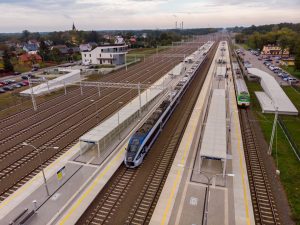 PKP Polskie Linie Kolejowe, PKP PLK, the railway infrastructure manger of Poland, obtained EUR 3.6 billion CEF Transport co-financing to increase the railway capacity and to modernise country’s rail network.
PKP Polskie Linie Kolejowe, PKP PLK, the railway infrastructure manger of Poland, obtained EUR 3.6 billion CEF Transport co-financing to increase the railway capacity and to modernise country’s rail network.
Thanks to the European funding, Poland implemented 24 rail projects with a total value of PLN 26 billion (EUR 5.8 billion) including the railway lines of European importance, projects which contributed to the rail amenity for passenger and freight transport, providing more fast, accessible and convenient services. The investment was also used for the development of the European corridors to promote efficient and environmentally friendly rail freight transport.
In total, 1,100 kilometers of railway lines are modernised using European funding.
The works were carried out on the railway lines that are part of the international TEN-T transport network, facilitating rail travel in agglomerations and improving conditions for freight transport.
“By investing, from both European and Polish budgets, we are consistently striving to achieve the goal of completing the work on the TEN-T core network by 2030.
These are the most important rail routes not only in Poland, but also throughout the European Union. Railway is an ecological, safe and sustainable transport mode, that is why we are focusing on railway projects,” said Małgorzata Jarosińska-Jedynak, the secretary of state at the Ministry of Funds and Regional Policy.
Besides the rail projects that received EU funding, Poland has also received this year funds for the construction works on Rail Baltica line on its territory.
“The adaptation of the Polish railway infrastructure to the European parameters is the most important goal resulting from the works carried out now on many investments co-financed by the CEF, including
on the international Rail Baltica line. Appreciating the fact that 2021 will be the Year of Rail, we hope that in the coming years the funds allocated by the European Union for this transport sector will be even greater,” Andrzej Bittel, secretary of state at the Ministry of Infrastructure, said.
Currently, PKP PLK is the largest beneficiary of the CEF Transport funding in Poland and also at the EU level. “PKP Polskie Linie Kolejowe received co-financing in the amount of almost EUR 3.6 billion from CEF Transport for the implementation of 24 projects.
This makes PKP PLK the beneficiary that receives the most funds from CEF. This is a big challenge, but also a great opportunity for the development of railways in Poland as ecological transport,” said Morten Jensen, Acting Head of Unit at INEA.
The financing from the Connecting Europe Facility is important for Poland’s rail agglomerations as in these areas the railway transport becomes more and more attractive and convenient to invest especially from European funds. Traveling around Warsaw is facilitated by the modernised commuter line connecting Warsaw West and Warsaw Gdańsk.
The stops are accessible to people with reduced mobility, and communication is integrated with the existing public transport such as the metro system. The completed modernsation of the line from Grodzisk Mazowiecki town (30 km southwest of Warsaw) to the capital ensures a quick and safe journey to work or school. In Krakow, thanks to the CEF investments the rail transport is becoming an unrivaled means of transport in everyday travel.
For the 2014-2020 MFF, under the Connecting Europe Facility, the national Centre for EU Transport Projects (CEUPT) concluded 57 Grant Agreements, amounting to EUR 3.9 billion of EU funds. PKP PLK is the largest beneficiary of funds for transport projects financed from CEF funds, for which 22 Grant Agreements were concluded for over EUR 3.17 billion of EU funds, and another two are being finalised, explained Joanna Lech, CEUPT Acting Director.
PKP PLK has recently announced it will launch EUR 3.8 billion tenders to modernise the railway infrastructure. At the same time, the company is preparing the project proposals for the new financial perspective and the comprehensive and completed documentation will allow the company to attract CEF funding on a “large scale than in this current financial framework”.
Share on:



